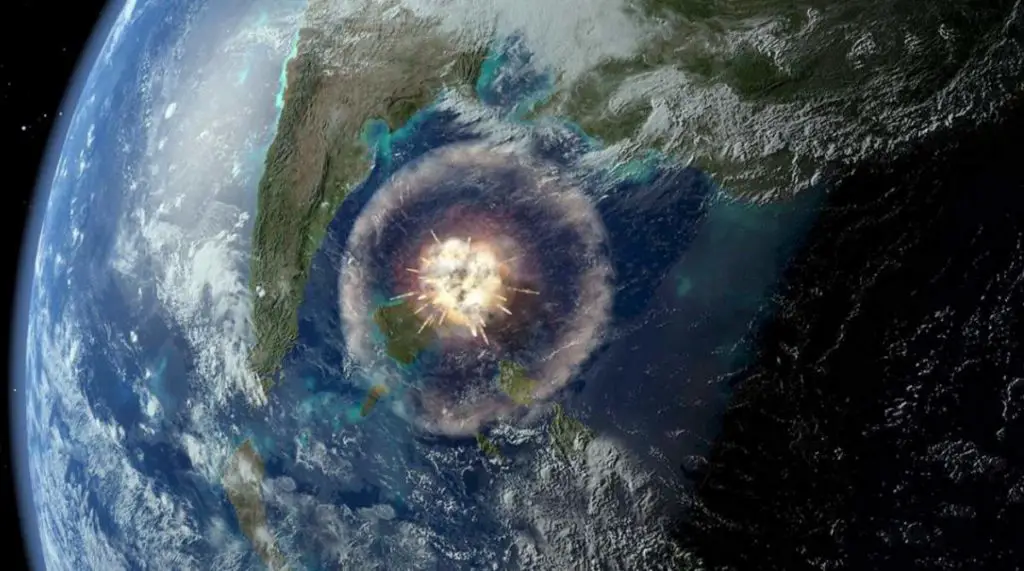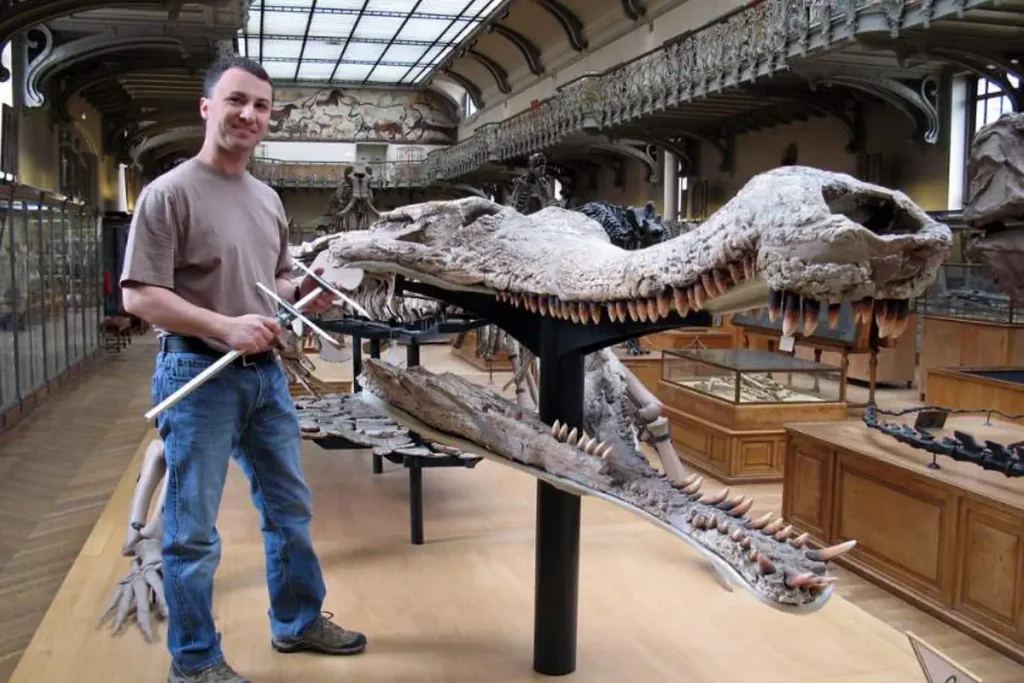The extinction event that led to the demise of the majestic dinosaurs is an enduring puzzle of natural history. However, while these behemoths vanished, a few robust creatures like crocodiles managed to thrive. So, what was the secret of their resilience? Why, and how, crocodiles survived when dinosaurs died?
The Catastrophic Chicxulub Impact: Setting the Scene
About 66 million years ago, Earth was a bustling habitat dominated by the mighty dinosaurs. Everything changed when an enormous asteroid, measuring at least 10 kilometers (6 miles) in diameter, collided with the Earth near the present-day town of Chicxulub in Mexico. The impact has created a crater (Chicxulub crater) more than 180 km (110 miles) in diameter, making it the third-largest known impact crater on Earth.
The Chicxulub event was catastrophic. The explosion triggered worldwide earthquakes, tsunamis, widespread fires, and even toxic rains. The location of the impact was particularly unfortunate, as the rocks in that area were susceptible to vaporization. This caused a massive upsurge of dust, shrouding the planet and blocking sunlight, plummeting the Earth into prolonged and chilling darkness.

The Domino Effect of Darkness
Without the warmth and energy of the sun, photosynthesis ceased. Green plants, the primary producers in the food chain, began to perish. This set off a chain reaction: herbivores starved due to the lack of vegetation, and subsequently, carnivores faced starvation as their prey dwindled.
It’s estimated that this cataclysmic event extinguished approximately three-quarters of all species on Earth. However, while many perished, a select few managed to weather the storm.
Fact: Dinosaurs did not actually go extinct
A remarkable group of dinosaurs, known as “avian dinosaurs” didn’t merely survive the asteroid’s aftermath – they evolved and thrived, embracing a whole new way of life. Possessing the gift of flight, these creatures could traverse vast terrains, allowing them to forage for food in places that remained untouched by the disaster. Their feathers, more than just facilitating flight, provided insulation against the sudden cold, creating a natural blanket against the biting chill.
Moreover, their sharp beaks became instrumental tools, adept at pecking and extracting buried seeds nestled beside decaying plants. Over millions of years, these agile survivors underwent myriad evolutionary changes, gradually transitioning into the diverse avian species we are familiar with today.
As we gaze up at the skies and admire the beauty of birds, it’s awe-inspiring to consider them as the living legacy of their mighty dinosaur ancestors.

The Crocodile’s Recipe for Survival
Crocodiles, unlike their avian counterparts, don’t possess the ability to fly, nor do they flaunt feathers. So, how and why they were managed to live, while dinosaurs died? (well, except for avian dinosaurs?)
In fact, even after the catastrophic Chicxculub impact, crocodilians have remained almost unchanged for a very long time because they have landed upon an equilibrium state that does not require them to change often, according to scientists.
Crocodiles’ survival strategies were unique and rooted in their innate biology and habitats.
1. Energy Efficiency: The Crocodile Advantage
Crocodiles are the epitome of energy conservation. Their physiology allows them to remain idle for extended periods, boasting a slow respiratory rate and heart rate. This unique trait lets them submerge underwater for over an hour and also survive without food for months, even surpassing a year at times. In a post-impact world where food became scarce, this energy efficiency gave crocodiles a substantial advantage.

2. Habitat Choice: Aquatic Lifelines
Many dinosaurs thrived in grasslands and forests. But these habitats were directly dependent on green plants. With the die-off of vegetation, these ecosystems collapsed. Crocodiles, on the other hand, primarily occupied aquatic environments like rivers, lakes, and coastal regions. These ecosystems were less reliant on live green vegetation.
Detritus from adjacent areas provided sustenance for microorganisms, forming the base of the aquatic food chain, which was topped by crocodiles. Thus, these reptiles had access to food even when terrestrial ecosystems faltered. these (please rewrite each list item that I added): “1. Wide diet.
3. Versatile Dietary Habits: The Crocodile’s Edge
Crocodiles can and will eat just about anything they can take down. They are opportunistic predators, capable of consuming a wide range of prey, from fish to mammals – both small and large.
As the dominant and menacing dinosaurs faced extinction, crocodiles found a plethora of new, smaller mammalian prey emerging in the ecosystem. This adaptability ensured they had a continuous food source, even amidst ecological disruptions.
4. Robust Immune Defense: Crocodile’s Shield Against Disease
Similar to bats, crocodiles boast a robust immune system that offers formidable resistance to diseases. The cataclysmic asteroid event not only depleted food sources but also likely ushered in waves of diseases. While many large dinosaurs succumbed to starvation and illness, crocodiles’ resilient immune defenses ensured they weathered this biological storm.
5. Reduced Competition: Rising in the Food Chain
Crocodiles’ inherent aggressive nature and resilience positioned them advantageously in a transforming world. As the apex predatory dinosaurs dwindled, crocodiles experienced reduced competition, allowing them to assert themselves more dominantly within their habitats and climb the ecological ladder.

Related: 10 Largest Crocodiles Ever Recorded
6. Prolific Reproduction: The Crocodile’s Abundant Offspring
One of the notable reproductive advantages of crocodiles is their capability to lay numerous eggs, ensuring a higher chance of survival for their offspring. In contrast, many dinosaurs had prolonged developmental phases, taking several years to reach maturity. Crocodiles, with their abundant offspring and relatively quicker maturation rates, had a reproductive edge in the changing world.
7. Hibernation Resilience: Crocodile’s Cold-Weather Adaptation
The aftermath of the asteroid event brought about severe climatic changes, including drastic drops in temperatures. While these colder periods proved fatal for many dinosaurs, crocodiles had the adaptive ability to enter a state of dormancy during cold spells. Finding refuge in safe hideouts, they would simply re-emerge once the conditions became more favorable. This physiological adaptation further cemented their survival through tumultuous times.
The Mammalian Ancestors: Small Yet Resilient
Humans owe their existence to the tenacity of small mammals, our distant ancestors. These diminutive, rat-like creatures survived by feeding on insects, worms, and detritus. Not being overly reliant on live green plants, they could extract sustenance from the remnants of a once-thriving ecosystem. These survivors eventually evolved, giving rise to a myriad of mammalian species, including humans.
Conclusion: Nature’s Resilient Threads
While the asteroid impact was a devastating blow to life on Earth, it also highlighted the incredible resilience of nature. Crocodiles, birds, and small mammals, each in their unique way, held on, ensuring that life persisted. It’s a poignant reminder that in the tapestry of life, adaptability and resilience are as crucial as strength and dominance. And while the avian dinosaurs, our modern-day birds, flutter around us, the crocodiles lurk in the waters, relics of an ancient world, basking in their unparalleled survival tale.
Sources
- Chicxulub crater on Wikipedia
- Bird on Wikipedia
- Moon Landings: All-Time List [1966-2025] - February 2, 2025
- What Is Max-Q and Why Is It Important During Rocket Launches? - January 16, 2025
- Top 10 Tallest Rockets Ever Launched [2025 Update] - January 16, 2025

